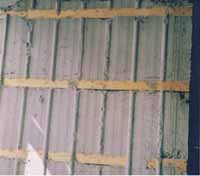
Opportunity Knocked
Jim Knisley
Features Companies Profiles Efficiency Jim Knisley Poultry ProductionRaising broilers on the Prairies can be a challenge, especially when dealing with temperatures of plus 40 C in summer to minus 40 C in winter.
When you’re faced with an 80-degree difference in temperature from the depths of winter to the peak of summer it can be a real test.
But it is a challenge Bruce and Sandy Hillman took on when they started A + Insulation four years ago.
It all began when a Saskatchewan broiler producer was getting quotes on topping up his attic insulation and encouraged Bruce to get into the business. Seeing there was a demand in the many aging broiler barns, they decided to seize the opportunity.
Based in the Edmonton area, they travel as far east as Saskatoon and as far as south as Lethbridge installing insulation in new and old barns.
Initially the business’s focus was on the most critical area – the attics. “Our initial concentration was on attics since 60 per cent of heat loss is through the ceiling. Many of the attics need topping up either because the original R-value is no longer sufficient for the present-day energy costs, or settling has occurred to the point where it is no longer adequate,” he said.
For attic insulation they use a cellulose product made by North Star Fibre.
But insulating doesn’t stop with insulation. “In doing a job we will quite often find the ventilation in the attic is lacking, which not only can cause condensation (wood and insulation damage), but in the summer can cause additional stress on the birds as the heat has nowhere to escape,” he said.
But they also sometimes see the other extreme: very open attics. Sometimes they are so open the wind gets in and may be causing a disturbance to the layer of insulation.
“Snow may be drifting in, and in some cases wild birds are actually able to enter and reside in the attic,” he said.
To deal with the weather Hillman said he recommends R50 for the attics. He said R40 is still a common figure for an attic but R50 offers much more protection at little extra cost.
“Even federal housing programs will not accept less than R50 and as I remind the producer a residential house has nowhere near the heating or cooling load required for a poultry barn winter or summer,” he said.
He added that sometimes insulating a new barn at 40 degrees below zero just days before chicks are to arrive is the best way to convince a farmer how much he can save by adding a little more insulation. “I can’t stress enough how important it is to weigh out the cost of heating a barn for 20 years over the cost of additional insulation up front,” he said.
Another area of concentration is the walls. “Being around broiler production for the past 30 years, I have seen numerous problems and issues with different types of barn construction.”
“It’s not uncommon to remove metal from the outside of an older barn and find the insulation virtually destroyed by rodents and bugs,” he said.
The solution is to reinsulate with the right insulation. They dense fill with cellulose insulation, which blows into every nook and cranny and is resistant to mice and bugs. An average 2 x 6 wall will end up with R20, and if strapped with 2 x 4’s, will insulate at about R25.
Many older barns built on the Prairies do not have plywood sheeting or house wrap. Not only does this allow for bugs and rodents, but also for unwanted airflow. This can reduce the R-value of any product that allows easy passage of air, such as the most common insulation – fibreglass batts, he said.
 |
|
| The solution is to reinsulate with the right insulation. dense filling with cellulose insulation blows into every nook and cranny and is resistant to mice and bugs.
|
Cellulose insulation allows less air movement, is more fire resistant and resists bugs and rodents. “I can’t stress how important it is to not only choose enough insulation, but one that is going to stand up to the conditions of the environment,” he said.
“Having proper insulation can save the poultry producer money and lot of headaches down the road,” he said.
It’s also important to pay some attention to the state of the insulation. “Insulation is usually out of sight and out of mind, but I would encourage producers to take a peek in their attic once in a while,” he said.
Producers should look for any sign of wet insulation and for good ventilation (but not to the point where the wind is disturbing the insulation). If there isn’t a minimum of R40 or about one foot of loose fill insulation, they might want to top it up.
As for walls, moisture on the inside or frost on the outside is a sign something may not be right. Laser thermometers for checking the floor temperature are also very handy for checking for cold spots on the wall, he said.
Anywhere augers or pipes come through the walls seems to be a prime spot for rodent or bug infestation. If the insulation is still intact, make sure any holes are filled with foam or silicone to discourage potential invaders.
Print this page